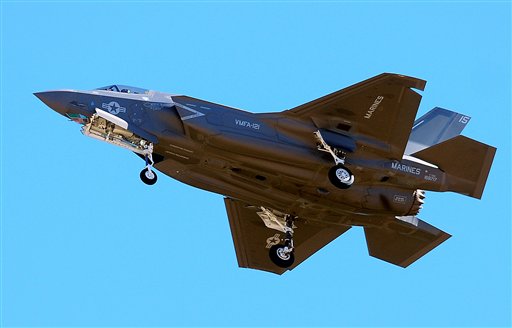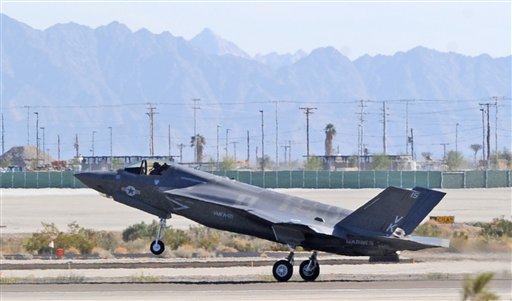SAN DIEGO — The Marine Corps is forming the first squadron of pilots to fly the next-generation strike fighter jet, months after lawmakers raised concern that there was a rush to end the testing of an aircraft hit with technical problems.
So far two veteran pilots of the 3rd Marine Aircraft Wing have been trained to fly the F-35B. They are becoming the first members of the Marine Fighter Attack Squadron 121 that will debut at a ceremony Tuesday at the Marine Corps Air Station in Yuma, Ariz.
The first F-35B arrived Friday and 15 more are slated to arrive over the next year. The Defense Department has pumped a half a billion dollars into upgrading the facilities, hangars and runways at the base to make way for the next-generation fighter jet, officials said.
The pilots of the new squadron are expected to fly the aircraft by year’s end.
The Marines are the first in the military taking the steps toward putting the planes in operation. The F-35B would replace Cold War-era aircraft such as the F/A-18 Hornet and AV-8B Harrier.
“It’s a pretty big milestone that a lot of people are looking at and judging,” said Marine Capt. Staci Reidinger, a spokeswoman at the Yuma base. “The lessons learned will be shared.”
Tuesday’s inauguration comes only months after leaders of the Senate Armed Services Committee suggested that Defense Secretary Leon Panetta rushed a decision to develop the Marine Corps version of the fighter jet.
In a letter sent in February to the Pentagon chief, Sens. Carl Levin, the committee chairman, and John McCain, the panel’s top Republican, questioned whether the F-35B had met the criteria to warrant an end to its probation. The F-35B had been on a two-year probation because of “significant testing problems.”
Levin, D-Mich., and McCain, R-Ariz., wrote that the program “has enjoyed some success over the last few months, after several years of having fallen short.” But they said “more problems with the F-35B’s structure and propulsion, potentially as serious as those that were originally identified a year ago, have been found. This is salient where the F-35B has completed only 20 percent of its developmental test plan to date. Your decision, therefore, appears at least premature.”
Neither McCain nor Levin could be reached for comment on the squadron.
The developer of the aircraft, Lockheed Martin Aeronautics Co., is building three versions of the F-35 — one each for the Navy, Air Force and Marine Corps.
Schedule delays and cost overruns have dogged the F-35’s development, making it the Pentagon’s most expensive weapons program ever. Ten years in, the total F-35 program cost has jumped from $233 billion to an estimated $385 billion. Recent estimates suggest the entire program could exceed $1 trillion over 50 years.
Aviation safety consultant and retired Marine Corps Col. Pete Field, who served as the former director of the Naval Test Pilot School, said the Marine Corps’ F-35B is the most complicated of the three versions because it can take off from shorter runways and land vertically. One of the problems earlier on in its development was it was heavier than predicted, Field said.
It was lightened substantially, but Field said that could also mean structural problems in the long run.
“It remains to be seen if the F-35B has a long life and is structurally sound,” said Field, who was the chief test pilot for the F/A-18. “We won’t know for two to three years after it’s been in operation. If nothing crops up, perhaps the engineers have done their best work.”
The F-35B stands out among military aircraft because it can be launched from small Navy ships and land in confined areas, allowing it to support ground troops on smaller battlefields. Its sophisticated stealth capabilities also means, like the Air Force’s F-22, the aircraft can fly into enemy territory without being detected by radar.
“All we can do is hope that they have solved all the program problems and that they’ve got a pretty good airplane,” Field said.
Former Marine and Rep. Duncan Hunter, Jr., R-Calif., who is the only member of Congress to have served in both Iraq and Afghanistan, said he trusts the decision of Panetta and Marine Corps leaders.
“The 35B is going to take the Marine Corps to a new level of sophisticated flight technology,” Hunter told The Associated Press. “The ability for the F-35B to take off and land in an extremely constrained lading zone, that’s huge for what it brings to the table. The Harrier was a great airplane but it was also limited. It doesn’t have all the new technology. The F-35B has that.”
Send questions/comments to the editors.



